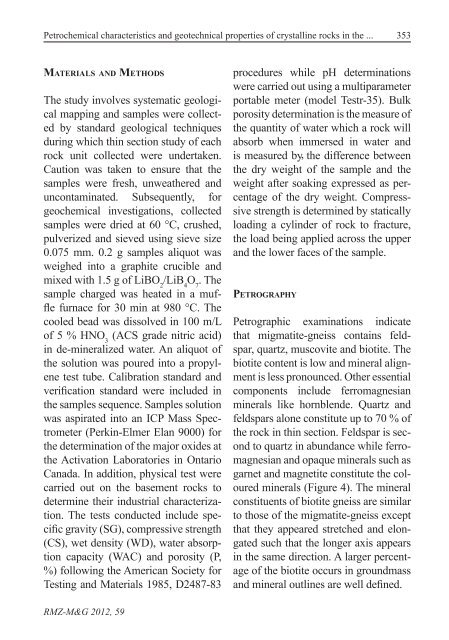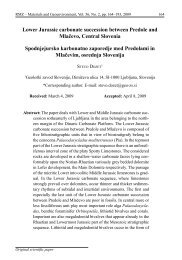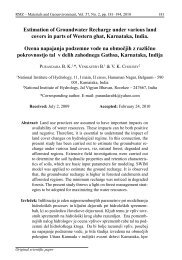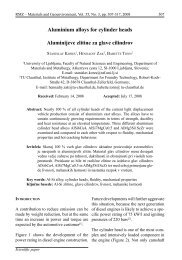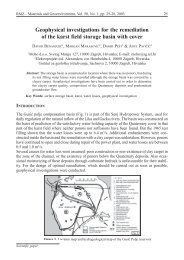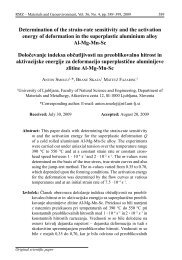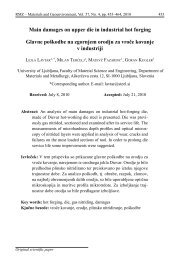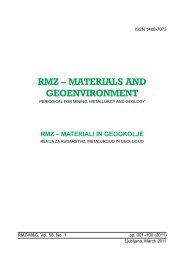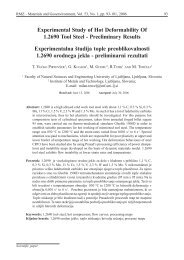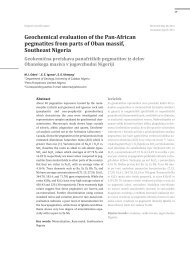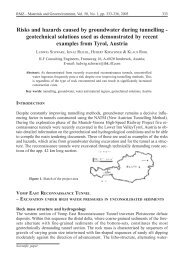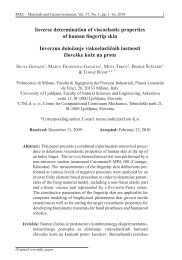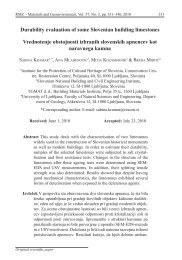RMZ â MATERIALI IN GEOOKOLJE
RMZ â MATERIALI IN GEOOKOLJE
RMZ â MATERIALI IN GEOOKOLJE
- No tags were found...
You also want an ePaper? Increase the reach of your titles
YUMPU automatically turns print PDFs into web optimized ePapers that Google loves.
Petrochemical characteristics and geotechnical properties of crystalline rocks in the ...353Materials and MethodsThe study involves systematic geologicalmapping and samples were collectedby standard geological techniquesduring which thin section study of eachrock unit collected were undertaken.Caution was taken to ensure that thesamples were fresh, unweathered anduncontaminated. Subsequently, forgeochemical investigations, collectedsamples were dried at 60 °C, crushed,pulverized and sieved using sieve size0.075 mm. 0.2 g samples aliquot wasweighed into a graphite crucible andmixed with 1.5 g of LiBO 2/LiB 4O 7. Thesample charged was heated in a mufflefurnace for 30 min at 980 °C. Thecooled bead was dissolved in 100 m/Lof 5 % HNO 3(ACS grade nitric acid)in de-mineralized water. An aliquot ofthe solution was poured into a propylenetest tube. Calibration standard andverification standard were included inthe samples sequence. Samples solutionwas aspirated into an ICP Mass Spectrometer(Perkin-Elmer Elan 9000) forthe determination of the major oxides atthe Activation Laboratories in OntarioCanada. In addition, physical test werecarried out on the basement rocks todetermine their industrial characterization.The tests conducted include specificgravity (SG), compressive strength(CS), wet density (WD), water absorptioncapacity (WAC) and porosity (P,%) following the American Society forTesting and Materials 1985, D2487-83procedures while pH determinationswere carried out using a multiparameterportable meter (model Testr-35). Bulkporosity determination is the measure ofthe quantity of water which a rock willabsorb when immersed in water andis measured by , the difference betweenthe dry weight of the sample and theweight after soaking expressed as percentageof the dry weight. Compresssivestrength is determined by staticallyloading a cylinder of rock to fracture,the load being applied across the upperand the lower faces of the sample.PetrographyPetrographic examinations indicatethat migmatite-gneiss contains feldspar,quartz, muscovite and biotite. Thebiotite content is low and mineral alignmentis less pronounced. Other essentialcomponents include ferromagnesianminerals like hornblende. Quartz andfeldspars alone constitute up to 70 % ofthe rock in thin section. Feldspar is secondto quartz in abundance while ferromagnesianand opaque minerals such asgarnet and magnetite constitute the colouredminerals (Figure 4). The mineralconstituents of biotite gneiss are similarto those of the migmatite-gneiss exceptthat they appeared stretched and elongatedsuch that the longer axis appearsin the same direction. A larger percentageof the biotite occurs in groundmassand mineral outlines are well defined.<strong>RMZ</strong>-M&G 2012, 59


